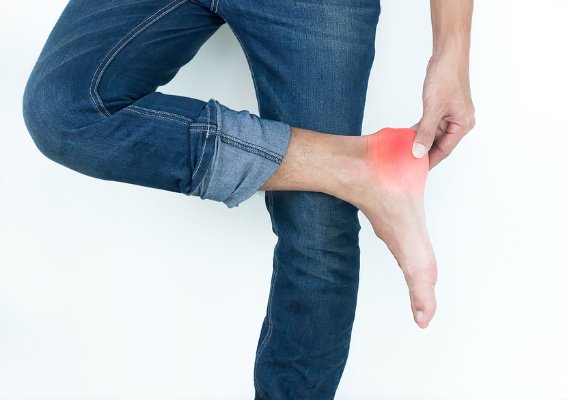
Plantar fasciitis is not an enjoyable injury to have. If you’ve noticed a sharp pain at the bottom of your foot, mostly towards your heel, then you may be experiencing plantar fasciitis. It’s a frustrating and sometimes debilitating injury that can happen to anyone, but is particularly common among runners and those who are overweight. If you’re looking for plantar fasciitis relief, you’ve come to the right place. Take a look at our best home remedies to treat and prevent pain!
What is Plantar Fasciitis?
Plantar fasciitis is the inflammation of the plantar fascia (the fibrous tissue) along the bottom of your foot that connects your heel to your toes. It can cause really bad heel pain that occurs when you take your first steps in the morning. The pain typically decreases as you move around and go about your day, but it can return after long periods of standing or getting up after you’ve been sitting down for a while. It usually affects one foot and is common among runners, as well as people who are overweight and anyone who wears shoes without proper support.
What Are the Symptoms of Plantar Fasciitis?
The major symptom of plantar fasciitis is pain at the bottom of your foot, most commonly under your heel, though some people experience the pain in the mid-foot area. For some people the pain is dull, but many people who have plantar fasciitis experience a sharp, stabbing pain. Some people also feel a burning or ache on the bottom of the foot.
The pain is often most noticeable when you get out of bed in the morning, or after you’ve been sitting or lying down. Climbing stairs can also be difficult due to heel stiffness. The pain can flare up after long durations of activity due to increased inflammation. You may not feel the pain during the exercise, but you’ll likely feel it after.
What Causes Plantar Fasciitis?
Plantar fasciitis is caused by tension or stress on your plantar fascia. Your plantar fascia acts as a bowstring that supports the arch in your foot. Small tears can arise in the fascia when too much stress is put on it. Excessive tearing and stretching of the fascia can cause it to become inflamed and irritated.
There are a few different reasons you may experience plantar fasciitis. You’re more likely to get plantar fasciitis if you’re a long distance runner or if you have an active job that requires you to stand on your feet all day. It also happens to be more common in women than in men.
If you’re overweight or obese, you’re also more likely to get plantar fasciitis due to the increased pressure on the plantar fascia ligaments. Women who are pregnant can also experience it, especially during late pregnancy.
If you have high arches or flat feet, you also may be more at risk for developing plantar fasciitis. Tight Achilles tendons may also lead to pain in the plantar fascia, and if you wear shoes with soft soles or poor arch support, you’re more likely to experience plantar fasciitis as well.
How to Prevent Plantar Fasciitis: 4 Tips
1. Wear Proper Shoes
Shoes without enough support can lead to serious pain in your feet. Invest in proper shoes to help prevent plantar fasciitis. These ones have a front rocker sole with a supported mid-foot to prevent and relieve plantar fasciitis. Stay away from high heels and shoes with soft or flat soles.
2. Work on Losing Weight
If you’re overweight, and especially if you’ve recently put on weight, you can be more prone to plantar fasciitis. Start working out and eating healthier to drop weight so you’re not putting as much pressure on the bottom of your feet.
3. Do Exercises
Certain exercises can help prevent plantar fasciitis. First, while seated, grasp your toes and gently pull them towards you until you feel a stretch in the arch of your foot. Second, in order to strengthen your arch muscles, place a towel on the floor, and grab the towel with your toes, pulling it towards you. Watch the video below for more exercises to help relieve pain from plantar fasciitis!
Plantar Fasciitis Stretches via Cleveland Clinic
4. Improve Your Running Technique
If you’re worried about getting plantar fasciitis from running, it’s important to make sure your running technique is on point. Learn to relax your lower legs, especially your ankles and calves. Tension held anywhere in your legs will pull on the plantar tendon when you move. You also want to land evenly on the middle of your foot, rather than striking your heel. This relaxes your plantar tendon and reduces the impact on your heels.
3 Plantar Fasciitis Remedies That Relieve Pain
1. Plantar Fasciitis Socks and Orthotics
You can try plantar fasciitis compression socks and plantar fasciitis orthotics. The socks provide fast relief of pain and provide instant arch support that will help with heel pain. They also feature gradual compression, compressing the plantar fascia ligament and relieving pain. The orthotics feature Shock Guard Technology for immediate and all-day relief from plantar fasciitis and the full-length insole cushions protect the entire foot.
2. Essential Oils
Certain essential oils can provide relief from plantar fasciitis – use them to massage your feet. Lavender essential oil provides a pain-relieving effect and is a natural analgesic that relieves inflammation and swelling. Bergamot essential oil counteracts inflammation, pain and muscle spasms, and has therapeutic effects that can alleviate the discomfort you feel. Peppermint essential oil is a natural painkiller. Two or three drops diluted in a carrier oil will provide a cooling sensation to your strained connective tissue.
3. Tape Your Foot
Taping your foot can help relieve your pain from plantar fasciitis. Use the tutorial below to learn how to tape your foot properly with KT tape.
KT Tape: Plantar Fasciitis via KT Tape
It’s no fun having plantar fasciitis, but these prevention tips and remedies can have you feeling great again!




































